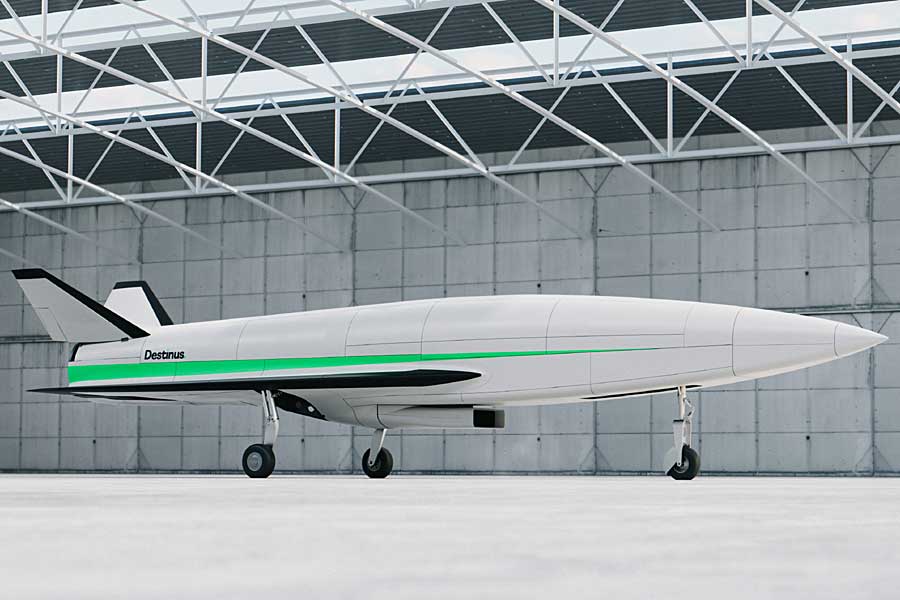Destinus unveils Destinus 3 hydrogen-powered supersonic demonstrator at Paris Air Show, paving the way to sustainable hypersonic aviation.
~
Press Release, Paris, 19 June 2023: [auto-translated] Destinus, a European aerospace company pushing the limits of high-speed hydrogen-powered aviation, unveiled its third demonstrator, the Destinus 3, at the opening of the 54th Paris International Air Show. This revolutionary model is set to become the world’s first hydrogen-powered supersonic unmanned vehicle, aiming to reach speeds of Mach 1.3. Destinus has scheduled its supersonic flight campaigns, powered by liquid hydrogen, for 2024.
Destinus is on a mission to launch the first fully hydrogen-powered commercial hypersonic aircraft, the Destinus S, between 2030 and 2032. With a proposed cruise speed of Mach 5 and seating for 25 passengers, the Destinus S is expected to outperform the Concorde by more than two and a half times. At such speeds, trips from Paris to New York would only take 1.5 hours.
In the 2040s, Destinus plans to introduce a larger model, the Destinus L. This behemoth is expected to carry 300 to 400 passengers to any global destination in just two to three hours, while reaching staggering speeds of up to at Mach 6. The Destinus L will harness cryogenic hydrogen for propulsion and cooling, setting new industry standards for efficiency and sustainability.
After passing flight tests with two previous demonstrators and rigorously examining its hydrogen engine on the ground and in flight, Destinus celebrates the inauguration of its third full-scale demonstrator, the Destinus 3. This 10-meter, 2-tonne advanced prototype is equipped with Destinus’ proprietary hydrogen afterburner technology and a new autopilot system. The design sets a new benchmark for supersonic capability and technological sophistication.
“Destinus 3’s propulsion system will incorporate a kerosene-fuelled turbojet engine in conjunction with a liquid hydrogen-powered afterburner. We are also developing plans to test a fully hydrogen-based system for the turbojet and afterburner.” , said Mikhail Kokorich, founder and CEO of Destinus. He added: “The demonstrator is equipped with a liquid hydrogen tank and an innovative fuel system featuring an electric pump. Destinus 3 is on track for its first subsonic flight in early 2024, with flight campaigns supersonic to follow at the end of 2024”.
The revolutionary hydrogen afterburner technology was successfully flight tested in May 2023 on the Destinus 1 demonstrator (Jungfrau). The Destinus 1, a 4-metre vehicle, and the Destinus 2 (Eiger), a 10-metre vehicle, have already demonstrated their power in subsonic flight. These two models have been instrumental in verifying the flight capabilities of a hypersonic airfoil based on a low-speed waverider concept and advancing the study of hypersonic airfoils, respectively.
“Hypersonics will revolutionise the technology and use of aviation in the 21st century. Europe must absolutely remain in a leading position in the aeronautical field, and not miss this turning point that the United States, China and Russia are preparing,” said Gen. Michel Friedling, former commander of France’s Space Command, a member of the Destinus advisory board.
“It should be noted that the hypersonic propulsion technologies developed by Destinus are based on the use of hydrogen. This underlines, once again, the unique role of hydrogen as the fuel of the future for aviation. commented Philipp Rösler, former Vice Chancellor of Germany, Minister of Economics and Technology, and current member of the Destinus Advisory Board.
Hydrogen fuel, with its heat of combustion three times that of kerosene and its exceptional cooling capabilities, has established itself as the optimal choice for building robust and efficient combined cycle engines. These engines would include a turbojet component for subsonic and supersonic speeds and a ramjet for hypersonic speeds. The use of hydrogen not only promotes efficiency, but also significantly reduces the environmental impact of future hypersonic flights, underscoring Destinus’ commitment to sustainable aviation.
~




















